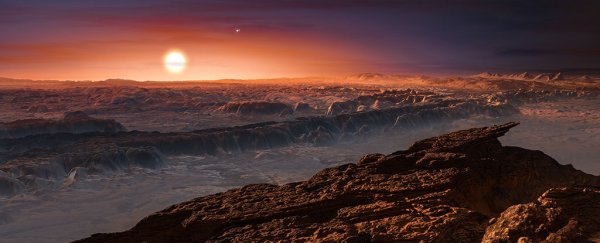Scientists have found that Proxima b – the closest Earth-like exoplanet to our own Solar System – could indeed be habitable, giving new hope that the right conditions to host alien life may lie on our cosmic doorstep.
The discovery of the planet made shockwaves through the science community last year, as this newly discovered world lies within the habitable zone of its host star – and now new modelling shows that Proxima b could offer a stable climate that's potentially suitable for extraterrestrial lifeforms.
According to simulations by researchers from the University of Exeter in the UK, Proxima b could support liquid water in a range of different orbital configurations, depending on how exactly it travels around its host star – something researchers have yet to figure out.
In case you're unfamiliar with Proxima b, it orbits a star called Proxima Centauri, which is located some 4.2 light-years away from Earth, making it the nearest solar system to our own.
That proximity alone makes Proxima b an extremely important find for scientists, who are already putting together some pretty ambitious plans to visit our potentially habitable neighbour.
Of course, as to whether Proxima b could actually sustain alien life, nobody's really sure, and scientists' best estimates so far haven't exactly been conclusive.
Previous research has suggested that Proxima b could be covered in water – which would boost its prospects for hosting life – but other findings have suggested that catastrophic solar flares unleashed by Proxima Centauri would create extinction-level events on the planet.
Hopes were further dashed in February, after a NASA study found that stellar eruptions could erode Proxima b's atmosphere, causing it to lose its atmospheric oxygen.
But now the University of Exeter team says that under the right orbital conditions, Proxima b could actually host a stable, water-supporting atmosphere.
Using the same modelling system designed to simulate Earth's meteorological conditions – the UK Met Office's Unified Model – the team found that Proxima b could support water if it had an atmosphere similar to Earth's, or even if it had an atmosphere consisting of only nitrogen and carbon dioxide.
"Our model is better able to take into account the variations in radiation received by the planet due to its orbit than previous models," one of the team, astrophysicist Nathan Mayne told Léa Surugue at International Business Times.
"We find that in the right conditions, Proxima B could have liquid water on its surface and could be habitable."
That conclusion also applied when the team tweaked the parameters affecting how Proxima b orbits Proxima Centauri in the simulations.
It's possible that the exoplanet is tidally locked to its star – like the Moon is to Earth, where we are only ever able to observe one side of our lunar satellite.
If that's the case with Proxima b, the simulations suggest it could support water – although there would be more of it if the planet rotates on its axis during its orbit.
The researchers simulated what's called a 3:2 resonance, where the planet rotates three times in full during two orbits of its star.
Mercury has a 3:2 resonance to our Sun, and the researchers suggest that if Proxima b does the same thing, even more of the planet could support liquid water, with light and heat from its star seeing water-supporting temperatures dispersed across the planet.
Of course, all of this remains purely hypothetical for now – but until we can get a lot closer to Proxima b, these kinds of simulations are the best resource we have for deducing the exoplanet's potential habitability.
And right now, we'll take all the pro-habitability Proxima b findings we can get.
"Of course, the challenge is now for observations to help us find out more about the composition of the planet's atmosphere," Mayne told Abigail Beall at Wired.
"As we learn more about the planet we can constrain our 'free parameters' more and more, and get a more precise estimate of what it might be like to stand on the surface of a planet like Proxima Centauri b."
The findings are reported in Astronomy & Astrophysics.
